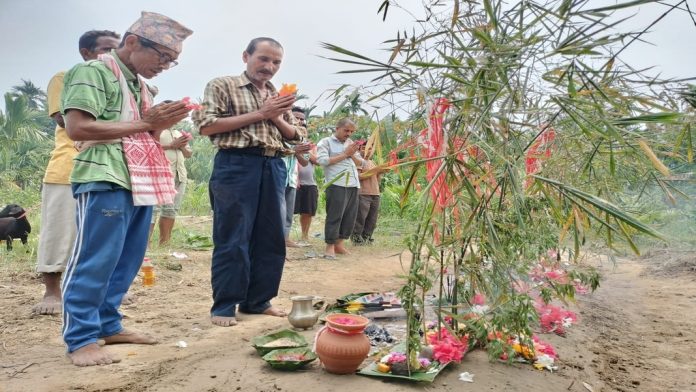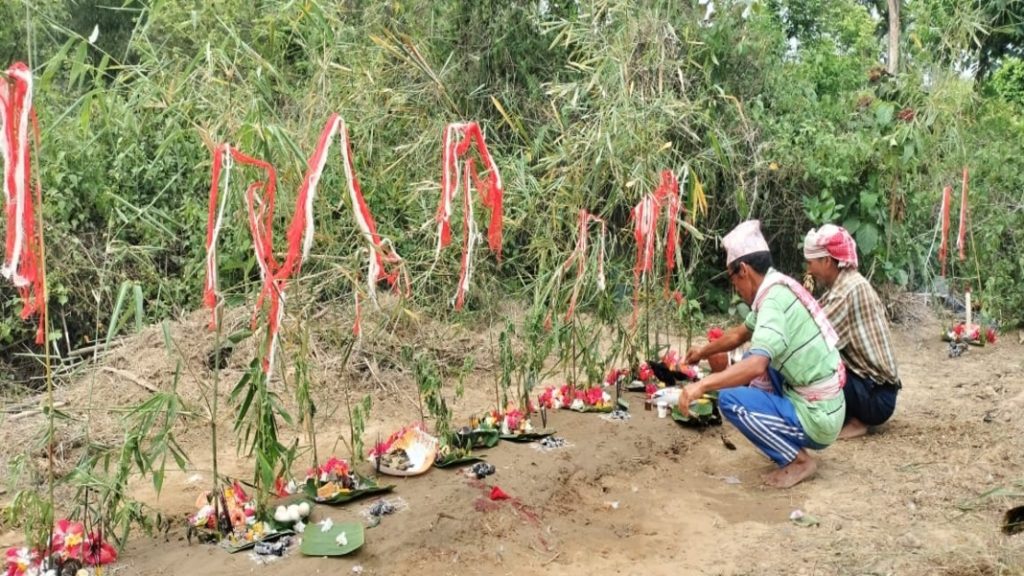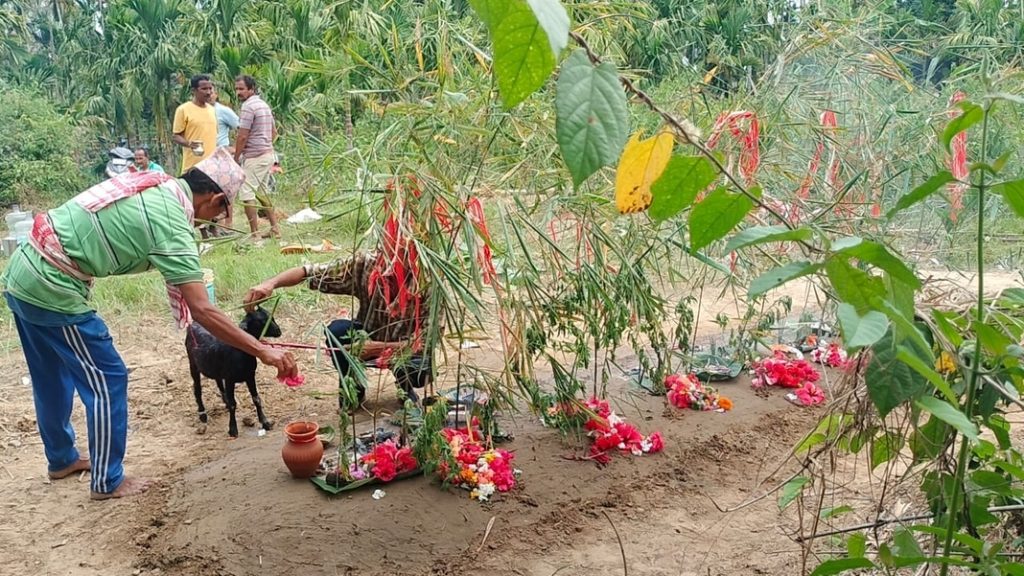
Nanda Kirati Dewan
With the advent of globalization, Gorkhas too are today a part of the greater ‘global village,’ while keeping their love for nature and conservation intact, worshipping ‘World’ as a ‘Woman’ and ‘Earth’ as ‘Mother,’ and this worship is called Sansari Puja. On Saturday, Sansari Puja was performed at Upper Assam’s Golaghat district under Merapani Sub-Division Sarupani Gaon Panchyat at Chandanpur village.

Restrictions to reduce human interaction have helped to avoid greater suffering and death from the COVID-19 pandemic, but have also created socioeconomic hardship. This disruption is unprecedented in the modern era of global observing networks, pervasive sensing and large-scale tracking of human mobility and behaviour, creating a unique test bed for understanding the Earth System. In this perspective, we hypothesize the immediate and long-term Earth System responses to COVID-19 along two multidisciplinary cascades: energy, emissions, climate and air quality; and poverty, globalization, food and biodiversity. While short-term impacts are dominated by direct effects arising from reduced human activity, longer-lasting impacts are likely to result from cascading effects of the economic recession on global poverty, green investment and human behavior. These impacts offer the opportunity for novel insight, particularly with the careful deployment of targeted data collection, coordinated model experiments and solution-oriented randomized controlled trials, during and after the pandemic. 2022 was a remarkable year after the Earth revived being challenged by humans’ supremacy. World Environment Day will keep reminding us of the wrongs we did to our environment and the rights we need to do to correct it all. The theme of World Environment Day 2022 was “Only One Earth”, focusing on “Living Sustainably in Harmony with Nature”. The day aims to focus on the importance of the environment and to remind people that nature should not be taken for granted. Therefore, World Environment Day calls for “collective, transformative action on a global scale to celebrate, protect and restore our planet,” encouraging everyone, everywhere, to live sustainably and address climate change. This year the theme is ‘Solutions to Plastic Pollution’ with the campaign #BeatPlasticPollution, which aims at reduction of plastic wastes which are hazardous to the environment.
Gorkhas have always been nature worshippers, connecting communities and realising their roots. They worship rivers, mountains, streams, forests and biodiversity and all these are always treated as sacred. For the Gorkhas, Nature is not a means of ‘resources extraction,’ rather it is treated as a benevolent ‘Mother’ who provides bounties for community sustenance. With the advent of globalization, Gorkhas too are today a part of the greater ‘global village’ while keeping their love for nature and conservation intact, worshipping ‘World’ as a ‘Woman’ and ‘Earth’ as ‘Mother’ and this worship is called Sansari Puja.
Sansari in Gorkha ‘bhasa’ means ‘The World is Ours’ and Puja means Worship. In layman’s language, ‘Sansari Puja’ would mean ‘Worship of Our Own World,’ which the United Nations (UN) celebrates as ‘World Environment Day.’
Sansari Puja is performed only on a Saturday between the 2nd week of April and 1st week of June. It, basically, begins in the month of Baishak in the Bikram Sambat calendar or Bohag in the Assamese calendar. It is to be noted that all through the year, Gorkhas have traditional festivals with respect to nature, farm, harvest, ancestors and offer home grown foods and fruits to their ancestors, to honour various aspects of nature. Sansari Puja begins in the month of Baishak (Bohag), the first month of a new annual calendar – to invoke Sansari Maai ( Maai is combination of two words Amaa and Aai which in Gorkha and Assamese language means Mother)– who the Gorkhas consider the Mother of all Creations – and to appeal to her for timely rain and to bless the community with abundant produce and a good harvest, with health and happiness in the year ahead. The shamans/priests also pray for the well- being of the community with peace and prosperity. Sansari puja is a community celebration, where people irrespective of their way of worship join the festivities. On Saturday, Sansari Puja was performed at Upper Assam’s Golaghat district under Merapani Sub-Division Sarupani Gaon Panchyat at Chandanpur village. The priests Dambar Bahadur Yakkha and Hari Bahadur Bhandari performed the Sansari Puja co-ordinated by village headman Rajat Basnet Chhetri and Village Defence Party (VDP) president Kul Bahadur Dewan assisted by Bhupal Roka Chetry and Prithvi Raj Yakkha in gracious presence of villagers.
Once the date for Sansari Puja is finalized, and which must be on a Saturday, elders from every household from the community come to the worship venue with rice, vegetables, dal, fruits and a mandatory local hen egg with flowers, home grown rice, mustard oil, incense sticks, pure ghee and diyas. This whole worship package is called Akxeta (meant only for worship or performing puja). The eggs have to be organic home grown chicken eggs as the fate of the donating family and the entire village for the year is predicted through these eggs. Each family writes the name of individual members in the eggs or name of the family in the eggs they donate, which is collected along with other Akxeta items and the villagers go to pray to Sansari Maai. Each community/village will have a designated place where they perform the puja to the Forest and other Nature Gods, and that is where the people go to pray for Sansari Maai. At the worship site, the traditional shaman or the village elder pray to Sansari Maai and invoke the ancestors and various protective deities. Invocation chants called the Mundhum include references to Yuma Theba (Grandfather and Grandmother), Hangba Raja-Hangba Rani…(Honourable King and Queen), Jangalma Basne Timi ( Dwellers of Forests)… Nad Nadi-Nala Dharti Timi (Oceans, Rivers, Streams and Land).. Ukkali-Orali, Derorali ko Devi-Deuta timi ( You are the God and Goddess of (Upon hills, Down Hills and God’s Hill)… Thado-Terso Dobhanama Timi ( You are in Horizontal, Vertical and All Directions)… Akash-Dharti-Patal ma Timi (You are in the Sky, Earth and Underground)… Charai-disa Khola-Nala timi (You are in all the four directions, Herbs and Shrubs, Streams and Lakes)…Brahmaputra ko Oripari Baroh Jilla Assam ko Raja Rani Timi ( You are the King and Queen of Brahmaputra Valley and 12 Districts of Assam )and so on*.. thus acknowledging the presence of Sansari Maai in each and every aspect of our environment. The Shaman/ priests then breaks each egg and reads out the projection for the year ahead for each family. A clear egg means the year will be uneventful, a fertilized egg could mean there will be birth in the family or ensuing prosperity, and an egg which has blood in it (very rare) is meant to convey there will be death in the family. The collection of eggs and the summary of the predictions provide a general picture for the village on what to expect in the year ahead. Afterall, the village is an extended family, so every birth and death becomes a family event. The various castes of Gorkha community are connected to each other by Sansari Puja, Sikooti (sun-dried meat) and Sel Roti ( Traditional Circular Bread) so it is a very important feast festival of Gorkhas.
Performed by a Shaman, Sansari Puja is divided into two halves. Firstly, the Lord Ganesha is worshipped in the form of Elephant with betel nut and leaf, flowers, etc. Than ‘Jal Shikari’ meaning ‘Hunters in Water’ are offered prayers with a local hen egg and all the worship items to keep the community free from water borne diseases. Thereafter prayers is offered to ‘Jungali’ ( Forest Dweller Ancestors) with a pair of local hen and cock sacrificed for them and tobacco items like cigarettes, biri, khaini etc along with all the puja items so that no untoward incidents happens in the forests, ochards, gardens for the entire year. The ‘Jal Daangrey’ meaning ‘Brahmaputra and All Water Bodies’ are offered prayers with a full grown male duck followed by ‘Maharani’ which is believed to be the mother of all households, is offered fresh and new harvest from the orchard or garden, along with pair of cock and hen sacrifice seeking her to stay happily in the home with blessings to the family. The ‘Maidani’ meaning ‘Even Land’ is worshipped with sacrifice of a hen with hope that no surface accidents happen in the community or the village.’ The ‘Lahurey Shikari’ is offered in second half so that no soldiers are killed or injured on the battlefield. Worship is completed with a sacrifice of a full grown old cock. Before offering prayers to Sansari Maai the Bhagawati – the nature god responsible for Sacrifices is offered prayers with a full grown pair of pigeons which are released in the sky to fly. The ‘Sansari Maai’ – is offered all worship items like ghee, oil, fresh flowers, fruit vegetables, roasted eggs and meats along with a young female goat that hasn’t conceived. It is sacrificed before ‘Sansari Maai’ with the belief that she would protect us from all untoward incidents, obstacles and shortcomings. The shaman/ priest also through the mundhum begs Sansari Maai for adequate rainfall, pleasant weather, good harvest and overall peace and happiness in the community and the village The place of worship is constructed using bamboo leaves and branches with banana leaves below. The leaves are decorated with mostly red and white cloth pieces and a few yellow ones, which is later distributed as sacred thread after the puja, to be tied on the right hand. All items needed in normal puja are used in the place prepared for Sansari Puja, besides sacrifices, home- made rice beer and indigenous wine. Vegetarians avoid sacrifices and create goats, hens, cocks out of water melon, gourds, pumpkins, fruits fixing four or two sticks as per the requirement in sacrifices. Even the vegetarians use the local hen egg which is mandatory for Sansari Puja.

The Sansari Puja is followed by a community feast which is cooked from the voluntary donations received in kind at the worship location and the sacrifice of animals and birds. People from all walks of life cook together in the community festival and eat together. Gorkhas of today’s generation in rural areas are glad that the community still celebrates Sansari Puja and upholds this unique tribal indigenous tradition but the same is not true for the urban dwellers. Gorkhas have a very unique and rich cultural heritage, and it is the duty and responsibility of youngsters to uphold their traditional practices for those are their roots and the stronger the roots, the taller the community can grow.
(Nanda Kirati Dewan is an international award winning senior community journalist with almost two decades of experience and is an Associate Member of the prestigious Gauhati Press Club since 2009. He can be reached at +919864077700 and E- [email protected] )





